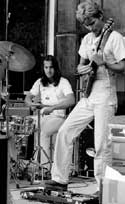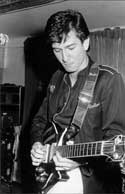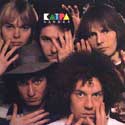Chapters >> 1 - 3 | 4 - 6 | 7 - 10 | 11 - 13 | 14 - 16 | 17 - 19 | Giglist
They had cult status in Sweden and they also toured Norway and Denmark. Some of their Copenhagen concerts were recorded for broadcast on Danish radio. The group was on a roll; they were playing many gigs and Finnish and British tours were on the point of being finalised. The group didn't have much in the way of management but many people were always on hand to sort out problems for them.
Kaipa had worked so hard and so intensively that they decided to take a break in December 1978. This was more than necessary; they were weary of touring and rehearsing and of the tensions that inevitably resulted from living together almost every day.
Roine bought himself an 8-track recorder. This gave him the opportunity to start recording of the solo album he had planned as he realised Electra Records wouldn't invest in recording his new music as a solo project at the time, rather concentrating on another Kaipa offspring named Ingemar Bergman Troop!
However, encouraged by Michael B. Tretow of ABBA recording fame who said it was "the best demo he heard in his life". Roine started to record his first solo album. The other Kaipa members clearly stated they wanted to use some of his songs for a new Kaipa album. This was a case of solidarity towards his main group, and not easily solved. But as Roine felt the chemistry was not the best in Kaipa at the time and this was probably a way of designing "a way out" of the bad vibe situation, heading towards new musical adventures and a more friendly and possibly ambitious environment. Also, the ambitious Roine, having a clear idea of his arrangements, drum patterns and the synthesizer patches, did not leave much room for the other Kaipa members to use their creativity and imagination. This forced the band into an inevitable situation making Roine the unspoken leader of the band as all the new material that seemed interesting to main part of the band was written by him, but also the member most likely to leave. In fact Hans was, at this moment, too disillusioned by his former attempts to bring new songs to the band, and he was asking himself several times if this was the intention he had when he once started the band, or if this was some kind of nightmare where he was transformed back in time to 1973 acting as a backing musician again, deprived all his creating ability.
By this time the chemistry in the band reached the lowest possible level. Mats Lindberg and Roine were talking about recreating the band or leave Kaipa, these were the only 2 options to stay healthy in a musically mad environment. Mats tried to persuade Roine frequently that they should leave the band and form a new group inspired by among others, UK, Weather Report and Toto. Roine hesitated realizing all the hard work and effort he had put into Kaipa even before Mats joined. Instead he suggested they should ask the others to leave as Ingemar and Mats Löfgren had Ingemar Bergman Troop to concentrate on anyway and Hans Lundin did seem disillusioned and lacking his initial energy and at a creative low at the time.
At this point Kaipa members realized that there was no way back and only one solution remained. They decided to split the band in two, but to fulfil all booked concerts together. The last concert with this constellation was given in Katrineholm on 13 May 1979.
Roine started to record his solo album "Fantasia", feeling relieved but with a sense of loss. Sensing also, understandably enough, a sort of "evil ray" coming from the remaining Kaipa members. So when recording the song "Nytt blod" (Fresh Blood) for his new album, the lyrics, a smiling and light-hearted support of his own progress, "criticize" his former partners for being inhibited and "victims of their own democracy". In fact Hans Lundin felt the democracy was already completely obliterated from the band at this time, left with little to contribute from him musically. Now Roine was gone, but when one goes there may always be someone else to step in, fill the space and claim the crown & throne.





The band was now back to a trio and they needed to find a guitarist and a bassist. Ingemar and Mats had their side project Ingemar Bergman Troop playing simple pop songs without any of the progressive parts that was characteristic for Kaipa. Hans was at this time a guest musician in their band playing on records and touring with the band. Ingemar suggested a fusion of the two bands. Hans wanted Kaipa to keep their profile, playing a progressive music but adding a little more up tempo and rock feeling to the music, and he was not interested in this fusion of bands. Instead they asked an old friend and brilliant guitar player Thomas Arnesen to join the band. Thomas once played in the band Panta Rei and later in several local bands like Hirvi and Puls. He had also filled in for Mats Lindberg, while he was in hospital, playing bass in Kaipa on one tour in 1978. They started to rehearse but, due to Thomas' family affairs, had to cancel the idea. Instead they asked another unknown guitar player recommended to them, Max Åhman from Stockholm, to join the band. He was a brilliant technician but didn't have the same melodic vein in his playing as Roine. They also asked Mats Lindberg to return to the band as a guest musician for a limited period.
The band decided to leave Electra and was signed by POLAR, ABBA's label, for a new album. At this time interest in progressive music had decreased, and the band was a little confused about which musical direction they should choose for the future. The process of making new music was difficult and filled with compromises. Ingemar wanted to act as composer and had some ideas, but his lack of knowledge of chords and other basic musical elements that was the fertile ground of the musical garden of Kaipa turned this into a strange situation. His way of thinking and working in music served a useful purpose in Ingemar Bergman Troop, but it was difficult to incorporate and in distinct contrast to Hans' way of writing and the overall music of Kaipa. Mats Löfgren acted as lyricist and added most of the vocal melodies.

The album "Händer" (Hands) was recorded late in the autumn of 1979 at Polar Studio in Stockholm with Leif Mases and Lennart Östlund acting as sound engineers. Hans used only two synthesizers (Yamaha CS-60 & Prophet 5) and a Grand Piano on the recordings. Like most keyboard players at the time he believed in the infinite possibilities of the polyphonic synthesizer and, therefore, sent his Hammond organ on a long vacation. Max was at this moment not completely incorporated in the bands music, which lead to a keyboard-oriented sound on this record. Three instrumental songs penned by Hans still had the characteristic Kaipa structure. Two of these, "El Grandi" and "Regn" (Rain), were included on the album. Another song, "Staden lever" (The City is Alive), was originally longer and contained some "symphonic" parts. These parts were in the songs final form deducted leaving only a short passage in the middle of the song. Most of the other songs on the album obviously proof the difficulties with the earlier mentioned compromise, showing different musical elements side-by-side, not integrated with each other, which was the purpose.
All songs, except the two instrumental songs, were credited to be composed by Bergman/Lundin/Löfgren. This was decided when the discussion about the collective creation was brought to daylight once again. Ingemar made a claim for being considered as part composer to all these songs, although his part of the musical process in some cases was quite limited. Good notices greeted "Händer" when it was released in the spring of 1980, but the album didn't attain the sales of its three predecessors.

Chapters >> 1 - 3 | 4 - 6 | 7 - 10 | 11 - 13 | 14 - 16 | 17 - 19 | Giglist